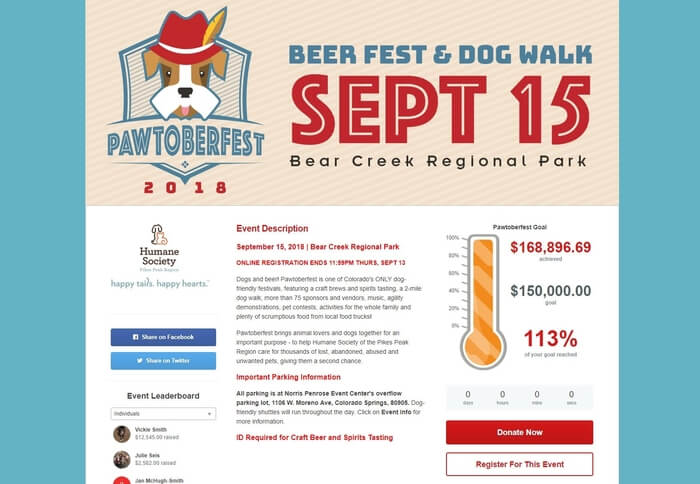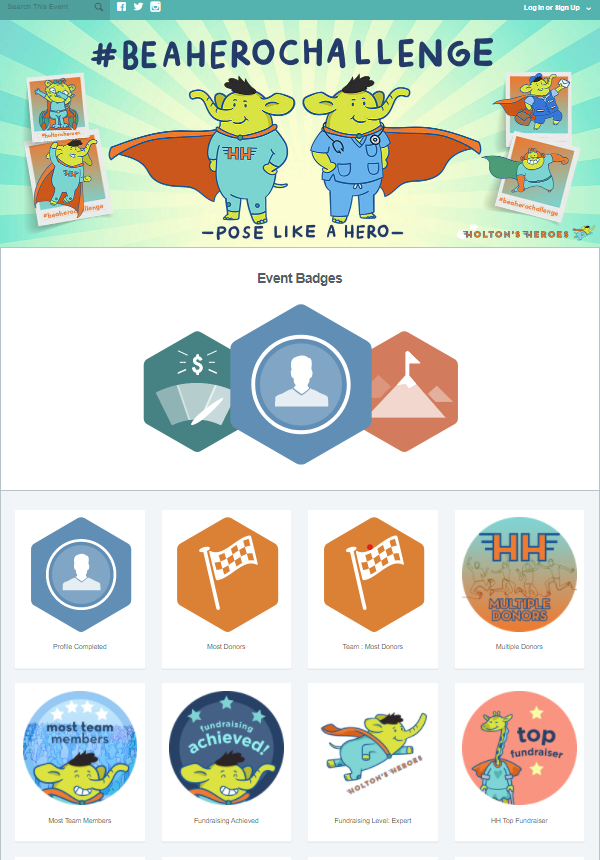Peer-to-peer campaigns are now one of the most popular fundraisers nonprofits all over the world embrace. In fact, 39% of Americans say they’ve donated to a charity based on a request from a friend or family member.
Not only is peer-to-peer fundraising a reliable method of collecting a great deal of money in a short amount of time, but it also effectively spreads the organization to new audiences and connects your participating supporters more deeply with your mission.
If you want to gain the most value from your next peer-to-peer fundraising campaign, it’s worth it to do some research and ensure you’re leveraging all of the opportunities that you can.
At Qgiv, we’ve worked with numerous clients to get their peer-to-peer fundraisers up and running. Using our expertise, we’ve compiled this guide to peer-to-peer fundraising tips and best practices. We’ll be covering the following topics:
Before we get into specific fundraising tips that you can implement in your next peer-to-peer campaign, let’s refresh your memory with the basics.

What is Peer-to-Peer Fundraising?
Peer-to-peer fundraising involves recruiting supporters to fundraise on your organization’s behalf to their individual networks of family and friends.
Because of their easy shareability, peer-to-peer campaigns are known to exponentially expand your campaign’s reach. With each peer-to-peer fundraising participant, you also have a brand new audience for your mission. And, more often than not, you’ll reach those who never would’ve heard of your organization or given to your cause if a loved one hadn’t advocated for it.
On top of that, peer-to-peer campaigns build a community for your supporters, offering a unique experience that brings them together under a common goal. Some campaigns even implement a competitive element for some friendly rivalry and extra motivation.
Typically, your peer-to-peer fundraisers will share a donation page encouraging their friends and family to support the cause that they care about. It’s recommended to use a dedicated peer-to-peer fundraising platform. This should allow each participant to create their own peer-to-peer fundraising page that others can donate to.
If you want to learn about the specific steps involved in launching a peer-to-peer campaign, we recommend exploring our ultimate guide to peer-to-peer fundraising.
Now, let’s dive into our top recommended tips.
10 Fundraising Tips for Your Next Peer-to-Peer Event
Any fundraising leader knows the importance of a good ask. How you approach supporters and relay your nonprofit story all affects the giving process. But, your peer-to-peer participants are not experienced fundraisers, so they’ll need a little help along the way.
Along with that, a common challenge is improving peer-to-peer fundraising participation. Successful peer-to-peer participants almost always do 4 specific things:
- They complete their fundraising pages
- They send fundraising emails
- They share to social media
- They work hard to meet the milestones you set for them
But how can you encourage the above?
From providing the right tools, to using gamification elements, use the following tips to get the most out of your peer-to-peer campaign and motivate your volunteers to fundraise harder.
1. Come up with an idea that fundraisers are excited about
In order to recruit your peer-to-peer participants, you need to come up with an idea that they’re genuinely excited about. This means fleshing out your goals and motivations for this fundraiser way before you begin.
Make sure you:
- Determine a SMART fundraising goal
- Establish what your organization will do with the funds
- Use past peer-to-peer events to back up your claims
When recruiting fundraisers, put them at the focus of your story. Explain the need for the peer-to-peer campaign and then discuss just how exactly their roles will benefit. When supporters can visualize and understand how their individual fundraising can impact your cause, they’re more likely to participate.
To garner even more excitement, consider hosting an event alongside your peer-to-peer campaign. Experiences like walkathons or game nights are popular peer-to-peer event ideas.
2. Prepare your fundraisers
You should assume that this is the first time that your participants have ever fundraised. Without conducting their own campaigns and working for a nonprofit, they likely don’t know where to start.
So, how can you effectively prepare your peer-to-peer fundraisers?
For starters, consider implementing a welcome quest to help your supporters get started. This should introduce participants to all aspects of the campaign, from how to use fundraising tools to how to send that first email out.
As you continue to prepare your volunteers, don’t forget to give them some actionable tips to jumpstart their fundraising. For instance, let them know how personal storytelling can incentivize more donations. Show them how they can use storytelling elements when they share their donation link or on the fundraising page itself.
And, in case they have any questions, make sure they’re assigned a go-to staff member who they can contact with any concerns.
3. Use branded pages
With peer-to-peer fundraising, each of your fundraisers is equipped with their own online donation page. This is an opportunity for them to tell their own story and advocate for your organization and campaign.
Make sure that each donation page is not only personalized to each participant but also branded to your organization. This means using:
- Your nonprofit’s signature colors
- Organization logo
- Mission statement
- Links back to your nonprofit website
This image shows just how you can brand a peer-to-peer event page. With the Humane Society logo on the left, the audience now knows exactly who the host organization is.
This way, new donors are properly introduced to your organization and they can start building a relationship with your brand. In fact, donations made on a branded donation form result in an average of 38% larger gifts than through a generic PayPal page. New supporters that your campaign reaches are also nearly 70% more likely to give again if the original donation page was branded.
4. Incorporate social media
Not only is social media a great place for your volunteer fundraisers to post their peer-to-peer pages, but it’s also a great platform to create awareness with unique content.
Recently, Facebook, Instagram, and TikTok have proven to be valuable platforms to spread the word about peer-to-peer campaigns in creative ways. From fun videos to real stories, social media makes it easy to share a link to a whole new audience.
For example, Camp Kesem is a widely-known organization that recruits college students to promote their peer-to-peer campaign on social media. Camp Kesem’s volunteers take to Facebook to post videos enticing people to give to their page.
These videos range from casual “Eating spicy ramen if we hit $500!” to more professional compilations of the community that Camp Kesem serves.
Look for a peer-to-peer platform with Facebook integrations to display real-time funds for Facebook users.
5. Ask your fundraisers to set personal goals (and raise them later!)
Consider your overall peer-to-peer campaign fundraising goal and divide that by each volunteer to help them set their own personal goals. This is an easy way to set an approachable goal to motivate participants.
For instance, if your overall revenue target is $10,000 and you have 50 participants, their personal goals could be $200.
Then, when they hit their goal, ask them to continue to raise it. Each time they hit a goal they can share this success with their friends and family and encourage even more donations.
6. Gamify your event
How can you sustain motivation as your peer-to-peer campaign continues? A key strategy is peer-to-peer gamification. This involves adding game mechanics to a non-game situation, offering a healthy dose of competition, increasing engagement, and motivating volunteers to out-fundraise each other.
Here are some quick tips if you want to gamify your own peer-to-peer event:
- Encourage fundraisers to form teams. A fun way to engage your volunteers is to group them into teams. Award the team who fundraises the most with a fun prize for some extra motivation.
- Come up with creative badges for top fundraisers. Badges are digital rewards that are given to volunteers when certain milestones or achievements are reached. These can be proudly displayed on their personal peer-to-peer page. Badges not only reward active fundraisers, but they also incentivize others to reach those same milestones. Consider giving badges for page completions, first donations, reaching $100, and more. Below you can see different badges for a peer-to-peer event hosted by Holton’s Heroes:
- Use leaderboards and fundraising thermometers. Leaderboards and fundraising thermometers are both widgets that can be added to peer-to-peer fundraising pages. The former showcases your top fundraisers while the latter displays how close you are to a fundraising goal in real time. Viewing this progress can motivate other fundraisers to increase their efforts.
With the right peer-to-peer platform, you should have access to a Fundraising Hub, a centralized place to host your donation and registration tools for all of your forms. It should show combined fundraising progress and allow you to track which participants or teams are doing best, making it easier to award badges or any other prizes.
7. Engage your fundraisers
While your peer-to-peer volunteers are passionate about your cause, they still lead busy lives. It’s critical that you consistently communicate with and engage volunteers to ensure the campaign stays on their minds.
Using your nonprofit’s email and text communication tools, make sure to:
- Schedule regular check-ins with fundraisers. This can be a simple Zoom call!
- Segment your audience based on peer-to-peer teams, team captains, badge holders, and more. You can even direct emails based on the percentage of the fundraising goal participants have met.
- Congratulate volunteers for their victories and properly thank them for their work.
Your peer-to-peer volunteers are not just fundraisers, but also supporters of your cause. Continuing to engage them and expressing gratitude for their work will let them know how valuable they are to your organization’s mission.
8. Ask volunteers to use their talents to encourage donations
Sometimes, the easiest way to increase peer-to-peer fundraising is to leverage your volunteers’ talents to solicit donations. A popular method is to simply host a talent show fundraiser.
Your peer-to-peer participants will ask their friends and family to “vote” for their talent by donating. The act that raises the most money will win and receive a prize.
This is a fun and creative way to incentivize peer-to-peer donations. Encourage your volunteers to showcase a wide range of talents. You can even host this virtually with video conferencing tools!
9. Encourage updates on their progress
As the peer-to-peer campaign continues, make sure to check in with your fundraisers. Getting a sense of their progress can clue you in to how likely it is that you will meet your fundraising goals.
However, it’s also a good idea to encourage participants to share progress with their own networks of friends and family. For instance, if they’ve set personal goals and met them, suggest that they take to social media and announce this milestone through a fun post or photo.
Or, if they’re really close to meeting a goal, they can relay that to their audience and say “I’ve given myself until midnight tonight to raise X dollars. I’m $50 away. Can you help me reach my goal?”
10. Have a plan for retaining those first-time donors
As mentioned earlier, many of your peer-to-peer donors will be first-time givers and newly familiar with your organization. While peer-to-peer efforts help you reach new audiences, it’s up to you to retain those supporters.
The first thing you have to do is send a donor appreciation email. As soon as a gift is made, each donor should receive a thank you along with a summary of their donation and impact.
Along with a thank you email, you might do the following:
- Encourage recurring gifts
- Invite them to sign up for nonprofit newsletters
- Send a final campaign update once it is all over
Still interested in how you can retain your peer-to-peer donors? Download a free copy of our eBook of peer-to-peer retention tips and tricks!
Bonus peer-to-peer fundraising tip: What should you not do in a fundraiser?
We talked a lot about what you should do during a peer-to-peer fundraiser if you want to inspire participants and reach your fundraising goal. But are there any specific actions that you should avoid? What are common risks?
Here are some of the most common mistakes that a peer-to-peer fundraiser might make:
- Overwhelming peer-to-peer participants with too many emails. If you find yourself contacting them multiple times a day with the same information, you risk them ignoring your communications altogether. Keep this to a once a week basis to check-in on progress.
- Setting an unrealistic fundraising goal. We mentioned this earlier, but it’s crucial that you set a SMART fundraising target. Look to similar past fundraisers to see a range for what a goal should look like.
- Only asking for money. Many of your peer-to-peer participants are soliciting gifts from their friends and family. However, that audience might grow tired if they’re only seeing direct fundraising asks instead of learning more about the organization and mission. Make sure that fundraisers also tell your nonprofit story, along with their own connections to it.
Keep these risks in mind as you begin planning your next peer-to-peer campaign. These are common pitfalls, so don’t worry too much if you find yourself slipping into one. Consistently check-in to make sure the event is moving as smoothly as possible and adjust strategies if necessary.

Peer-to-Peer Fundraising Additional Resources
Getting your peer-to-peer fundraiser off the ground needs careful planning and consideration. On top of that, getting your participating fundraisers fully prepared and engaging them throughout the campaign is another challenge to tackle.
To help you make the most of your peer-to-peer fundraising campaign, we recommend exploring these additional peer-to-peer fundraising resources:
- 11 Simple (but Impactful!) Ways to Improve Your Peer-to-Peer Fundraising. Are your peer-to-peer fundraising results not what you’d hope they be? Check out this webinar by Mark Becker, a founding partner at Cathexis Partners.
- Fundraising Mash-Up: How to Combine Auctions with Peer-to-Peer Fundraising. An auction can often be paired with peer-to-peer fundraising is an auction. In fact, auction fundraisers themselves are known to raise a great deal of money. Find out what happens if you combine these efforts in our blog post.
- 6 Ideas for Engaging Peer-to-Peer Fundraising Participants and Increasing Donations for Virtual Events. Virtual events have only grown in popularity and will likely be involved in future nonprofit events in one way or another. Don’t miss out on our top tips for engaging peer-to-peer participants during a virtual event.
- Free eBook – Retaining Your P2Peeps. Retaining your new peer-to-peer donors and participants can be a challenge once your campaign is over. Download our eBook that we’ve created with Bloomerang to help your nonprofit receive stable revenue for years to come.










